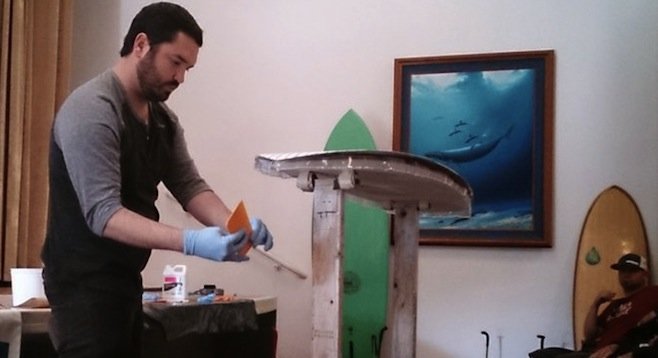 Facebook
Facebook
 X
X
 Instagram
Instagram
 TikTok
TikTok
 Youtube
Youtube

At Scripps Institute of Oceanography last weekend, February 15, more than 70 people gathered to learn why “The Future of Surfing Is Not Disposable” — this was among the topics at the Groundswell Society’s 12th annual Surfing Arts, Science and Issues conference.
Almost 20 speakers came together to discuss the fate of coral reefs in a high carbon dioxide future, the life cycle of a sustainable surfboard, emerging technologies, and putting sustainability into action.
Usually, toxic resins are used in the fabrication of surfboards and skis, but that’s changing. Entropy Resins has developed an earth-friendly formula that isn’t yellow. Co-founder Rey Banatao said life-cycle analysis of the new white resin shows a 50 percent reduction in CO2 production.
SUPERbrand’s Jason Koons said Entropy’s Super Sap epoxy bioresin is now as good as any resin on the market, and he used it to glass a surfboard at the front of the auditorium.
Sustainable Surf cofounder Kevin Whilden pointed out that “we did not issue gas masks to everyone in this room because they’re not needed.” From the front row, I detected only a slight odor. “Kind of smells like Thai food,” Koons quipped.
Entropy cofounder Rey Banatao played a video that showcased one of his company’s latest projects: recyclable composites. Immersed in non-toxic hot vinegar, hardened resin dissolved from carbon-fiber cloth, allowing both to be reclaimed. Imagine a ski that could be separated into its constituent parts for reuse. Plastics had to be redesigned to allow them to be recycled, Banatao explained.
Resins aren’t the only surfboard component going greener; their cores are, too. Rob Falken of Tecniq showed off one of his pale green BIÓM surfboard blanks made from 99 percent polymerized sugarcane biomass and expanded with CO2 “borrowed” from the air. It’s lightweight, waterproof, durable, industrially compostable, and launching in a few months.
Enjoy Handplanes’ Ed Lewis has gone beyond shaping hand-planes from broken surfboards and created one of compressed hay, but he dreams of using mushroom-based foam. Although it isn’t ready for use in blanks yet, mushroom foam has been shaped into surfboard fins and used to protect NOAA buoys.
(adapted from an article first posted on The Inertia)


At Scripps Institute of Oceanography last weekend, February 15, more than 70 people gathered to learn why “The Future of Surfing Is Not Disposable” — this was among the topics at the Groundswell Society’s 12th annual Surfing Arts, Science and Issues conference.
Almost 20 speakers came together to discuss the fate of coral reefs in a high carbon dioxide future, the life cycle of a sustainable surfboard, emerging technologies, and putting sustainability into action.
Usually, toxic resins are used in the fabrication of surfboards and skis, but that’s changing. Entropy Resins has developed an earth-friendly formula that isn’t yellow. Co-founder Rey Banatao said life-cycle analysis of the new white resin shows a 50 percent reduction in CO2 production.
SUPERbrand’s Jason Koons said Entropy’s Super Sap epoxy bioresin is now as good as any resin on the market, and he used it to glass a surfboard at the front of the auditorium.
Sustainable Surf cofounder Kevin Whilden pointed out that “we did not issue gas masks to everyone in this room because they’re not needed.” From the front row, I detected only a slight odor. “Kind of smells like Thai food,” Koons quipped.
Entropy cofounder Rey Banatao played a video that showcased one of his company’s latest projects: recyclable composites. Immersed in non-toxic hot vinegar, hardened resin dissolved from carbon-fiber cloth, allowing both to be reclaimed. Imagine a ski that could be separated into its constituent parts for reuse. Plastics had to be redesigned to allow them to be recycled, Banatao explained.
Resins aren’t the only surfboard component going greener; their cores are, too. Rob Falken of Tecniq showed off one of his pale green BIÓM surfboard blanks made from 99 percent polymerized sugarcane biomass and expanded with CO2 “borrowed” from the air. It’s lightweight, waterproof, durable, industrially compostable, and launching in a few months.
Enjoy Handplanes’ Ed Lewis has gone beyond shaping hand-planes from broken surfboards and created one of compressed hay, but he dreams of using mushroom-based foam. Although it isn’t ready for use in blanks yet, mushroom foam has been shaped into surfboard fins and used to protect NOAA buoys.
(adapted from an article first posted on The Inertia)
Comments